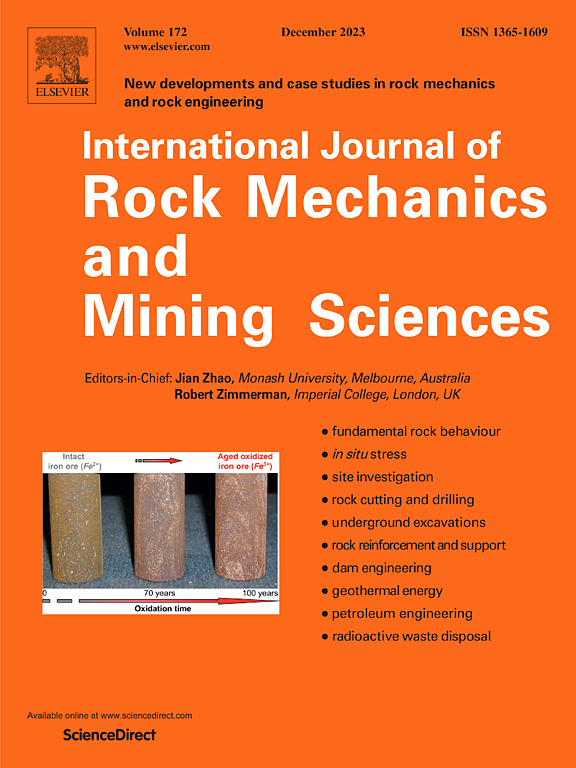考虑真剪性的岩石节理三维峰值抗剪强度新准则
IF 7
1区 工程技术
Q1 ENGINEERING, GEOLOGICAL
International Journal of Rock Mechanics and Mining Sciences
Pub Date : 2025-04-21
DOI:10.1016/j.ijrmms.2025.106119
引用次数: 0
摘要
在正常约束条件下,接触岩石表面之间的抗剪能力是由真正参与剪切的凹凸不平体决定的,即真剪切凹凸不平体。然而,考虑真剪颗粒力学贡献的节理峰值抗剪强度预测仍未得到解决。在这里,我们通过独立量化真剪岩石的剪胀和剪断,建立了三维峰值抗剪强度准则。通过识别初始视倾角超过峰值扩张角(实际接触面积比和三维形态参数的函数)的凸起来预测真剪切凸起。实际接触面积比是通过关节局部孔径的统计分布来预测关节整体孔径的非线性缩减来量化的。随后,通过评估真剪颗粒的剪切部分,确定剪切面积比和相关剪切分量。对天然节理和人工节理的峰值抗剪强度进行了实验验证。该准则所涉及的输入参数很容易从关节的形态特性和法向变形性中获得。因此,该方法可作为一种快速简便的天然岩石节理抗剪强度评估方法,对常规剪切试验有一定的补充作用。本文章由计算机程序翻译,如有差异,请以英文原文为准。
A new three-dimensional peak shear strength criterion of rock joints considering true-sheared asperities
The shear resistance between contacting rock surfaces under normal confinement is governed by the asperities truly involved in shear, i.e., true-sheared asperities. However, the prediction of joint peak shear strength considering mechanical contributions of true-sheared asperities remains unresolved. Here, we developed a three-dimensional (3D) peak shear strength criterion by independently quantifying dilation and shear-off of true-sheared asperities. The true-sheared asperities were predicted by identifying the asperities with initial apparent dip angles exceeding the evaluated peak dilation angle that was a function of the real contact area ratio and 3D morphological parameters. The real contact area ratio was quantified by the nonlinear reduction of the global joint aperture that is predictable via the statistical distribution of local apertures of joints. Subsequently, the shear area ratio and associated shear-off component were determined by evaluating the shear-off portion of the true-sheared asperities. The new criterion was validated against experimental measurements on the peak shear strength of both natural and artificial joints. The input parameters involved in this criterion are readily acquirable from morphological properties and normal deformability of joints. Therefore, it potentially can serve as a fast and convenient shear strength assessment method for natural rock joints that may complement conventional shear experiments.
求助全文
通过发布文献求助,成功后即可免费获取论文全文。
去求助
来源期刊
CiteScore
14.00
自引率
5.60%
发文量
196
审稿时长
18 weeks
期刊介绍:
The International Journal of Rock Mechanics and Mining Sciences focuses on original research, new developments, site measurements, and case studies within the fields of rock mechanics and rock engineering. Serving as an international platform, it showcases high-quality papers addressing rock mechanics and the application of its principles and techniques in mining and civil engineering projects situated on or within rock masses. These projects encompass a wide range, including slopes, open-pit mines, quarries, shafts, tunnels, caverns, underground mines, metro systems, dams, hydro-electric stations, geothermal energy, petroleum engineering, and radioactive waste disposal. The journal welcomes submissions on various topics, with particular interest in theoretical advancements, analytical and numerical methods, rock testing, site investigation, and case studies.

 求助内容:
求助内容: 应助结果提醒方式:
应助结果提醒方式:


